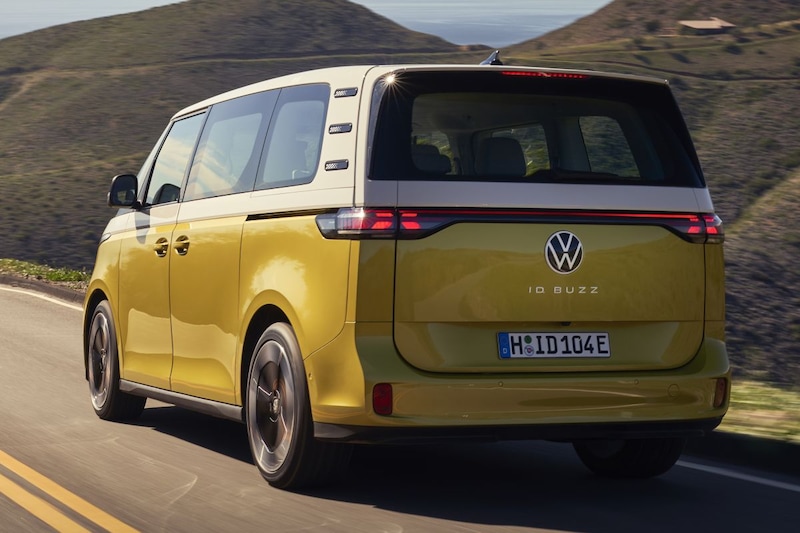Niels van Roij does not think retro MPV is a modern T1 interpretation


No Volkswagen makes the crampedness within the group more visual than the ID Buzz, thinks
car designer Niels van Roij. In this design review, he holds the youngest member of the Volkswagen ID family up to the light.
Ralf Brandstätter, Chairman of the Board of Directors of Volkswagen Passenger Cars is little
coy about its new member: “The ID Buzz is a true icon for the electric age. A car as only Volkswagen can build. In the 1950s, the Volkswagen Bulli represented a new sense of car freedom, independence and great emotion. The ID Buzz picks up on this lifestyle and transfers it to our time: emission-free, sustainable and ready for autonomous driving.”
Go ahead. Post-diesel scandal, Volkswagen has apparently lost all hesitation and enters as stylishly as a teenager in the McDonalds parking lot in his worn-out, soot-vomiting Golf 3.

You don’t design an icon, it arises
Back to Brandstätter’s claims about the so-called iconic value of the Buzz: an automotive icon is not designed, it is created. An iconic car comes from one
influential concept representing design over a specific period of time. A
culturally defining idea, embodied by the car. This is how the VW T1 became, among other things, in the 1960s
a symbol of hippie culture. Groups of youths used the buses decorated with colorful paintings and peace signs to transport friends and camping gear.
ID Buzz has no flower power but faint power
The ID Buzz has no flower power, but faint power. The color scheme reminiscent of
the classic Bulli, is mounted on a generically drawn body and makes the newcomer
by no means iconic. The character line on the body, on which the color separation is applied,
degenerates on the nose into a hesitating just-just-not-not situation: no end in sharp T1 point,
no square demarcation. While the VW Bus in the 1950s represented a new sense of freedom and independence, the only way the ID Buzz still links to that philosophy today is in the way it suddenly frees its yuppy owner from a minimum of 70k and the financial hippie- dumb in catapults.
Outline reminds neither of T1 nor of modern VW buses
Conceptually, the Bulli 2.0 is as empty as Brandstätter’s hollow phrases. The design is the embodiment of the enormous contraction that has prevailed within the Volkswagen Group since the diesel scandal in 2014. The brand is clearly searching, especially on the conceptual level and its aesthetic implementation. The A-line, which defines the silhouette, is non-descript. An outline that is not reminiscent of the T1, but also not of the DNA of a modern Volkswagen bus. The shape of the side glass, the Day Light Opening, and all window styles lack characterful corners, as does a range of shapes with essential T1 design elements. The down the road graphic has been dragged in by the hair. The apparently ID-bound horizontal strip between the headlights is as forced as it is misplaced.

Volkswagen ID Buzz: this is how it should be!
With the Microbus, VW had a brilliant 1960s icon
How should it be? Volkswagen itself showed this in 2001 with the Microbus Concept. A brilliant
shaped, fresh interpretation of the 1960s icon. After that, the Modern Bus
Interpretation-Design exercise repeated many times. Including the Bulli Concept in 2011,
BUDD-e in 2016 and the ID Buzz concept in 2017. None of them could match the Microbus that captured the exact essence of the T1 and translated it into a spectrum of shapes that, even more than 21 years later, looks many times fresher and more relevant than the ID Buzz. It is in no way innovative or daring in terms of design technology.
(text continues below the photos)

Volkswagen Bulli from 2011

Volkswagen BUDD-E in 2016

Volkswagen ID Buzz concept
With a confident design – see brave Microbus – the half-hearted just-just-just-not retro sauce would have been unnecessary. ID Buzz is not a modern T1 interpretation, nor has Wolfsburg shown the courage to go completely retrospective and, for example, to stick a really pronounced large logo on the nose and to apply the 23 Samba bus windows, among other things, in the roof.
The only ‘great emotion’ that Ralf Brandstätter can still feel now is disappointment.
.
– Thanks for information from Autoweek.nl






